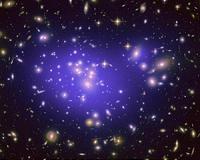 |
Paris, France (ESA) Aug 27, 2010 One of the most complex space scientific instruments ever built, the Alpha Magnetic Spectrometer (AMS-02) arrived at the Kennedy Space Center in Florida, escorted by astronauts who will fly with it on the Space Shuttle in February 2011. The antimatter hunter AMS-02 began the first stage of its voyage to the International Space Station (ISS) from Geneva international airport, in Switzerland. During a ceremony organised by the European Organisation for Nuclear Research (CERN), the experiment was loaded onto the US Air Force Galaxy transport aircraft that carried it to Cape Canaveral. AMS-02 will not only be the largest scientific instrument to be installed on the ISS, but it could also be considered the result of the largest international collaboration for a single experiment in space. Even before its launch, the Alpha Magnetic Spectrometer has already been hailed as a success with more than a decade of work and cooperation between 56 institutes from 16 different countries. The AMS-02 experiment is led by Nobel Prize Laureate Samuel Ting of the Massachusetts Institute of Technology (MIT).
Searching for the 'missing Universe' With a magnetic field 4000 times stronger than the magnetic field of Earth, this state-of-the-art particle physics detector will examine directly from space each particle passing through it in a programme that is complementary to that of the Large Hadron Collider. As a by-product, AMS-02 will gather a lot of other information from cosmic radiation sources on stars and galaxies millions of light years from our home galaxy. Not only astronomers, but also particle physicists, are eagerly waiting for its data.
Long life to the AMS-02 The experiment is expected to remain active for the entire lifetime of the ISS and will not return back to Earth. "The ISS is set to be utilised for scientific and exploration purposes, so it is important to count on an instrument that can remain fully active for more than a decade," emphasised Di Pippo. Exhaustive tests in ESA's testing facilities at ESTEC, Noordwijk, The Netherlands, played an important role in the decision to replace the original superconducting magnet for a permanent one with a longer life expectancy. After its arrival at the Kennedy Space Center, AMS will be installed in a clean room for more tests. A few weeks later, the detector will be moved to the Space Shuttle, ready for its last mission.
Share This Article With Planet Earth
Related Links AMS-02 Stellar Chemistry, The Universe And All Within It
 Cosmic Lens Used To Probe Dark Energy For First Time
Cosmic Lens Used To Probe Dark Energy For First TimePasadena CA (SPX) Aug 20, 2010 Astronomers have devised a new method for measuring perhaps the greatest puzzle of our universe - dark energy. This mysterious force, discovered in 1998, is pushing our universe apart at ever-increasing speeds. For the first time, astronomers using NASA's Hubble Space Telescope were able to take advantage of a giant magnifying lens in space - a massive cluster of galaxies - to narrow in on ... read more |
|
| The content herein, unless otherwise known to be public domain, are Copyright 1995-2010 - SpaceDaily. AFP and UPI Wire Stories are copyright Agence France-Presse and United Press International. ESA Portal Reports are copyright European Space Agency. All NASA sourced material is public domain. Additional copyrights may apply in whole or part to other bona fide parties. Advertising does not imply endorsement,agreement or approval of any opinions, statements or information provided by SpaceDaily on any Web page published or hosted by SpaceDaily. Privacy Statement |